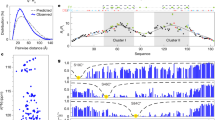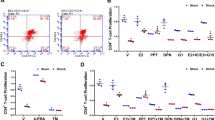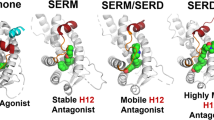Abstract
Overexpression of the human REL transcription factor can malignantly transform chicken spleen cells in vitro. In this report, we have created and characterized a cDNA encoding a chimeric protein (RELΔ424–490-ER) in which sequences of a highly transforming REL mutant (RELΔ424–490) are fused to the ligand-binding domain of the human estrogen receptor (ER). Surprisingly, RELΔ424–490-ER is constitutively nuclear in A293 cells, and RELΔ424–490-ER activates transcription in the absence, but not in the presence, of estrogen in κB-site reporter gene assays. Furthermore, RELΔ424–490-ER transforms chicken spleen cells in the absence of estrogen, but the addition of estrogen blocks the ability of RELΔ424–490-ER-transformed cells to form colonies in soft agar, even though estrogen induces increased nuclear translocation of RELΔ424–490-ER in these cells. ERα can also inhibit REL-dependent transactivation in trans in an estrogen-dependent manner, and ERα can interact with REL in vitro. Thus, the RELΔ424–490-ER fusion protein shows an unusual, reverse hormone regulation, in that its most prominent biological activities (transformation and transactivation) are inhibited by estrogen, probably due to an estrogen-induced interaction between the ER sequences and sequences in the Rel homology domain. Nevertheless, these results indicate that the continual activity of REL is required to sustain the transformed state of chicken spleen cells in culture, suggesting that direct and specific inhibitors of REL may have therapeutic efficacy in certain human lymphoid cancers.
This is a preview of subscription content, access via your institution
Access options
Subscribe to this journal
Receive 50 print issues and online access
$259.00 per year
only $5.18 per issue
Buy this article
- Purchase on SpringerLink
- Instant access to full article PDF
Prices may be subject to local taxes which are calculated during checkout




Similar content being viewed by others
References
Boehmelt G, Walker A, Kabrun N, Mellitzer G, Beug H, Zenke M and Enrietto PJ . (1992). EMBO J., 11, 4641–4652.
Capobianco AJ and Gilmore TD . (1993). Virology, 193, 160–170.
Cerillo G, Rees A, Manchanda N, Reilly C, Brogan I, White A and Needham M . (1998). J. Steroid Biochem. Mol. Biol., 67, 79–88.
Evans MJ, Eckert A, Lai K, Adelman SJ and Harnish DC . (2001). Circ. Res., 89, 823–830.
Fan Y, Rayet B and Gélinas C . (2004). Oncogene, 23, 1030–1042.
Galien R and Garcia T . (1997). Nucleic Acids Res., 25, 2424–2429.
Gee AC, Carlson KE, Martini PGV, Katzenellenbogen BS and Katzenellenbogen JA . (1999). Mol. Endocrinol., 13, 1912–1923.
Gilmore TD . (1999). Oncogene, 18, 6925–6937.
Gilmore TD, Cormier C, Jean-Jacques J and Gapuzan M-E . (2001). Oncogene, 20, 7098–7103.
Gilmore TD, Kalaitzidis D, Liang M-C and Starczynowski DT . (2004). Oncogene, 23, 2275–2286.
Grumont RJ, Rourke IJ and Gerondakis S . (1999). Genes Dev., 13, 400–411.
Horigome T, Ogata F, Golding TS and Korach KS . (1988). Endocrinology, 123, 2540–2548.
Kalaitzidis D, Davis RE, Rosenwald A, Staudt LM and Gilmore TD . (2002). Oncogene, 21, 8759–8768.
Kalaitzidis D and Gilmore TD . (2002). Genes Chromosomes Cancer, 34, 129–135.
Kumar V, Green S, Staub A and Chambon P . (1986). EMBO J., 5, 2231–2236.
Maia DM, Sciarrotta J, Abendroth K and Blatt J . (2000). Leuk. Lymphoma, 39, 365–371.
Picard D . (2000). Methods Enzymol., 327, 385–401.
Ray A, Prefontaine KE and Ray P . (1994). J. Biol. Chem., 269, 12940–12946.
Ray P, Ghosh SK, Zhang D-H and Ray A . (1997). FEBS Lett., 409, 79–85.
Robyr D, Wolffe AP and Wahli W . (2000). Mol. Endocrinol., 14, 329–347.
Sharma RV, Gurjar MV and Bhalla RC . (2001). J. Appl. Physiol., 91, 2400–2406.
Sif S and Gilmore TD . (1994). J. Virol., 68, 7131–7138.
Starczynowski DT, Reynolds JG and Gilmore TD . (2003). Oncogene, 22, 6928–6936.
Stark JJ, Lloyd JW and Schellhammer PF . (1981). Ann. Intern. Med., 95, 186–187.
Stein B and Yang MX . (1995). Mol. Cell. Biol., 15, 4971–4979.
Tzagarakis-Foster C, Geleziunas R, Lomri A, An J and Leitman DC . (2002). J. Biol. Chem., 277, 44772–44777.
Valentine JE, Kalkhoven E, White R, Hoare S and Parker MG . (2000). J. Biol. Chem., 275, 25322–25329.
van Gool A, Boersman C, de Jongh C, Mulder W and Olijve W . (2002) Keystone Symposium on NF-κB: Bench to Bedside. Abstract.
Walker AK and Enrietto PJ . (1996). Oncogene, 12, 2515–2525.
Zurovec M, Petrenko O, Roll R and Enrietto PJ . (1998). Oncogene, 16, 3133–3142.
Acknowledgements
We thank Nancy Rice for anti-REL antiserum, Gloria Callard for 17-β-estradiol, David Waxman for MCF-7 cells, Ulla Hansen for pcDNA-ER, Pierre Chambon for pHE14, and Erin Coffee for constructing the GST-REL expression plasmid. This work was supported by NIH Grant CA47763 (to TDG), and a small grant from the Boston University Undergraduate Research Opportunities Program (to JO). DTS was partially supported by a pre-doctoral Fellowship from the Natural Sciences & Engineering Research Council of Canada.
Author information
Authors and Affiliations
Corresponding author
Rights and permissions
About this article
Cite this article
Kalaitzidis, D., Ok, J., Sulak, L. et al. Characterization of a human REL-estrogen receptor fusion protein with a reverse conditional transforming activity in chicken spleen cells. Oncogene 23, 7580–7587 (2004). https://doi.org/10.1038/sj.onc.1207912
Received:
Revised:
Accepted:
Published:
Issue date:
DOI: https://doi.org/10.1038/sj.onc.1207912
Keywords
This article is cited by
-
RelB/NF-κB links cell cycle transition and apoptosis to endometrioid adenocarcinoma tumorigenesis
Cell Death & Disease (2016)
-
The role of the NFκB signalling pathway in cancer
Clinical and Translational Oncology (2008)



